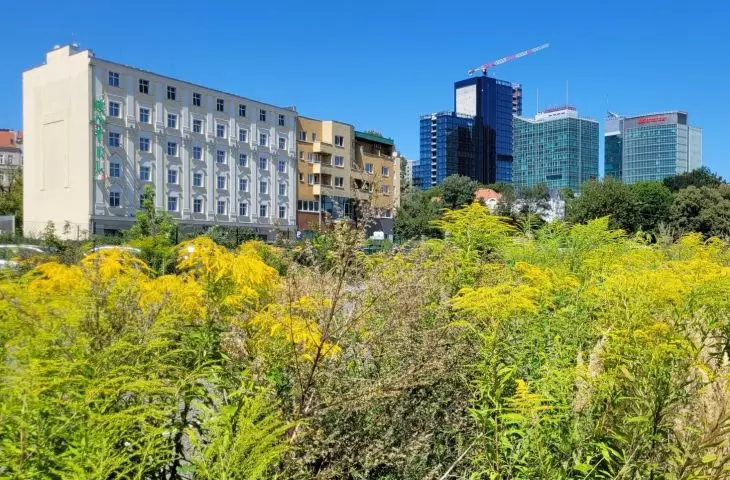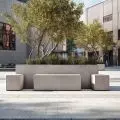The concrete and asphalt fallow land after the city's largest market was supposed to turn into a spacious part of the new Wilda Park. For now, however, it will be just a "green corridor." The reason? Some officials announced the greenery, while others leased part of the land earmarked for it for parking lots. Until 2029!
The case concerns an important area on the outskirts of the inner city near the iconic Old Brewery, next to the Szyc (formerly July 22) stadium , which has been closed for a quarter-century. The area between the stadium and Dolna Wilda Street served as a large bazaar after 1990, and later as an orderly market known by the customary name "Bema Market" (from the name of neighboring Bema Street later renamed Droga Dębińska). Shrinking with time, the market was finally closed in 2020. The temporary hall was removed, and grass and shrubs began to squeeze in between the concrete and asphalt. Only the fenced sub-standard parking lots along Dolna Wilda held on to the old way.
The site of the former Bema Market in Poznań - one of the parking lots along Dolna Wilda Street, which are expected to exist until 2029, with the former stadium in the background
photo: Jakub Glaz
The site after "Targowisko Bema" in Poznań - view from the south, in perspective - Andersia office and hotel skyscraper complex (the tallest one under construction), as of 30.07.2024
photo: Jakub Głaz
machining
This summer the City announced: we have money to green the former market, with work starting in October. It was also widely reported that funds in the amount of PLN 14 million came from the National Fund for Environmental Protection and Water Management. The money has also been earmarked for the greening of the spacious courtyard of the school on Wyspianski Street (the work is nearing completion, see: There was asphalt and concrete, there are more squares) and the planting of a pocket forest in place of the concrete berm after the open-air model of the Rataje district in the Piast residential area (work has not started).
The square after the open-air model of the Rataje district liquidated in the early 1990s. - view of Piastowskie housing estate from the side of Warta river
photo: Jakub Glaz
October is just coming to an end, and no construction work has started on the former bazaar site. Worse: it turned out that greenery will not appear in place of the operating parking lots. Thus, instead of a rather wide park space, a green avenue is to be created. The matter was publicized a week ago by Poznan's Gazeta Wyborcza, following the actions of the Wilda Estate Council, which - during a meeting with officials in August - was surprised by the City's intentions. The councilors were shown a depleted area designated for revaluation. It was explained that the City Roads Administration... has extended the contracts with the parking lot tenants, and the area cannot be transformed into a friendly and cohesive space for the next few years. Dorota Bonk-Hammermeister, a city councilor and chairwoman of the Wilda Estate Council, therefore issued an interpellation on the matter . She wrote, among other things:
I believe that in this way we are losing the chance to comprehensively arrange the space between Szyc Stadium and Dolna Wilda Street with greenery. Leaving unsightly and increasingly unnecessary parking lots in this place (the Paid Parking Zone operating on Wilda has caused these parking lots to be mostly empty), will cause the effect of a multi-million dollar investment to be lost.
The site of the former "Bema Market" in Poznań - plan - area for greenery truncated by parking lots leased by MIatso until 2029 - on the left side of the stadium, from Olimpijska Street to Fr. Żelazka Street (off plan at the bottom)
source: openstreetmap
piece by piece and over the years
The councilwoman also asked whether the City Roads Board had been informed of the intentions of the City's Project Coordination and Revitalization Bureau (BKPiRM) to green the area. She inquired whether, when leasing its land, the city checks whether such activities comply with the provisions of local development plans. Indeed, the plan in effect for the former market allows for the creation of "parking lots in the green space," and this on the condition that the parking lot at the neighboring Multiplex is removed (the multiplex is soon to be demolished and replaced with a residential building [cf. Multiplex and shopping center under the pick]).
Deputy Mayor Mariusz Wisniewski responded on behalf of the City Council. He informed that the lease agreement was concluded by the city's roadbuilders in 2023 for three years, after which... it was extended until 2029! The response also reads that
The City's Project Coordination and Revitalization Office informed the City Roads Board of plans to develop the area around Szyc Stadium in 2023. In September and October of this year, scoping arrangements took place for the areas around Szyc Stadium.
It also turned out that after the closing of the market, the area of one of the parking lots was expanded to include the space previously occupied by commerce. Dorota Bonk-Hammermeister does not hide her disappointment:
This answer sounds evasive, because it doesn't touch the heart of the matter. We did not get an answer as to why the city is making inconsistent decisions and whether they are in accordance with planning documents. Thanks to the letter, I know that there has been an exchange of information between officials, but I still don't know how this can translate into a change of the unfavorable situation. At the August meeting I heard that greenery will be introduced "piece by piece," which is a waste of money and time.
The site of the former "Bema Market" in Poznań, view of the former entrance to the stadium from the west side
photo: Jakub Głaz
it's not the first better site
Such a haphazard and careless approach is surprising, because the former market is one piece of a larger and important urban puzzle at the downtown edge of the so-called southern green wedge, one of four natural strips of great importance to the city (one wedge on each side of the world). The wedges begin on the outskirts of the center and connect to the forests beneath the city. The cross-shaped arrangement of these strips connected to the green "ring" around the city was visualized before the war and written into the city plans by Wladyslaw Czarnecki, a respected urban planner and architect.
And it was the southern wedge that aroused the most emotion in the last two decades, because it was subject to the strongest investment pressures. It took many years of social action to save its most important downtown section from dense development. In the place of the abandoned and devastated Szyc stadium, private investors wanted to erect first a shopping center and then tall residential buildings. In a deliberative poll arranged in 2012, however, Poznań residents opted primarily for the recreational and green character of the space on which the stadium stands.
Concept for the development of the former stadium site and its surroundings, 1st prize in the 2023 competition, designed by Studio Fikus, bird's-eye view from above the Old Brewery to the south, the area after the market - in the upper right quadrant of the visualization, visible water reservoir on the slab of the stadium transformed into a "park of silence"
© Studio Fikus
Eventually, the city authorities managed to protect the site from development with the local plan already mentioned here. The stadium, with its earthen stands now overgrown with a mature youngster, is to become a "park of silence" in the future. The conceptual competition for the development of the abandoned arena and its surroundings was decided last year. It was won by Studio Fikus from Gliwice. The very interesting project is to be the basis for detailed studies in the future [see: competition results].
Unfortunately, for the time being it is not known how exactly the green "corridor" in the former market place will be developed. No detailed design has been shown, and announcements that it will be consistent with the concept awarded a year ago are too vague. The example of the activities on the site after the Bema Market shows once again (we have written about it many times before) that in Poznań deep and urgent reform is required of communication between municipal units and coordination of their activities.














































